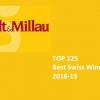History (History)
Switzerland and Wine: a Long Story
The native territory of Vitis vinifera, the common grape vine, is a band of area from Western Europe to the Persian shores of the Caspian Sea. The earliest evidence of grape vine cultivation and winemaking dates 7000 years back. Then, between 3000 BC and 2000 BC, viticulture emerged in force in the areas of Asia Minor, Greece and the Cyclades of the Aegean Sea, becoming an important component of local economies and trade. Roman expansion across Western Europe also brought Roman viticulture to the areas that would be home to some of the world's best-known winegrowing regions: the Spanish Rioja, the German Mosel, and the French Bordeaux, Burgundy and Rhône.
Halfway through the 20th century, winemaking spread oversees, first to South Africa, then to the Americas, Australia and New Zealand. The vine has demonstrated high levels of adaptability and sometimes mutates to accommodate a new environment after its introduction. Because of this, viticulture can be found on every continent except Antarctica.
Vine has been cultivated in Switzerland since the Roman era. Although there are traces attesting to even more ancient origins, many autochthonous varieties bear names with Latin roots. Christianity and the use of wine for Holy Communion ensured the sustainability of cultures since the Middle Ages.
In the Lavaux World Heritage site and Valais, that was the time when monks cleared the slopes of vegetation and terraced them, building hundreds of miles of walls that trace, support and surround the plots of vineyards. Still maintained by winegrowers, these stone walls break the land into smaller, less steep plots that are easier to cultivate; they also limit soil erosion during strong rainfalls.


Luckily, wine is not only drunk during church services and, despite some highs and lows, wine production in Switzerland still thrives to this day. Year after year, Swiss winegrowers dedicate their talent to producing the very best wines from very diverse “terroirs”.
Switzerland is a small country and although viticulture plays an important role in its geographical and economic landscape, it is little known beyond the borders through lack of exports. Only 2% of the Swiss production is consumed outside the country, despite its high quality – widely acknowledged by experts.
Switzerland is formed of 26 cantons and four linguistic areas (German, French, Italian and Romansh), creating a richness of cultures that is reflected in the variety of traditions and ways of living, drinking and eating.
Its wine-producing geography is divided into three regions that match the linguistic and cultural borders: the Italian-speaking part of Switzerland (canton of Ticino), the oriental part (German- and Romansh-speaking regions) and the French-speaking area. The latter extends along the Upper Rhone Valley, from Brig to Geneva, and produces 70% of Swiss wine.
Its wine-producing geography is divided into six regions. The Three-Lakes (Neuchatel, Bienne and Morat) lies to the west, with its back to the Jura Mountains. The Ticino region is located on the southern side of the Alps, looking towards Italy. Eastern Switzerland includes many small vineyards located for a large part on the course of the Rhine river. The last three regions Valais, Vaud and Geneva are aligned in a row along the Rhone river between Brig and Geneva. Valais is the largest and probably the most Alpine Swiss vineyards due to its location, its climate and soil. Vaud stretches along the shores of Lake Geneva, it includes the famous world heritage Lavaux vineyard. The Geneva vineyard finally is located at the southwest corner of Switzerland.
Fifteen varieties provide 90% of Swiss wines. Of course each region cultivates varieties that are best suited to their land, but what will probably get the attention of connoisseurs, are the original grapes such as the red cornalin and humagne, the white amigne, arvine, and of course the white chasselas.
Contact us
- Swiss Fine Trade Sàrl
- Route de Vevey 84
1618 Châtel St-Denis, Switzerland - Editor in chief: Jean-François Genoud
- contact [at] swissfinewine [dot] ch
- Contact form
About
Swiss Fine Wine is a comprehensive and multilingual website about the finest Swiss wineries and wines selected through the aggregated lists of experts. Joins us to discover, visit, taste, pair, Swiss wines in Switzerland or anywhere in the world.
This is a private initiative dedicated to promote, explain and discuss Swiss Fine Wines. We cater to the curiosity and needs of private individuals, wine amateurs, enthusiasts, professionals as well as companies such as restaurants, hotels and distributors who wish to learn more about fine Swiss wines.


